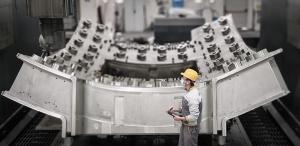Manufacturing

©F4E
How is the ITER fusion reactor being manufactured? All the participants to the ITER Project are involved in the procurement of machine components and plant systems. In addition one Member—Europe—is responsible for procuring the buildings and technical facilities of the scientific installation.
During the negotiations that led up to the signing of the ITER Agreement, the original sharing of procurement was decided between the Members—about 45.5 percent for Europe, and 9.1 percent each for China, India, Japan, Korea, the Russian Federation and the United States.
The lion's share of Member contributions to ITER (90 percent) will be delivered "in-kind." That means that in the place of transferring money, the Members will be delivering components, systems (and for Europe ... buildings) directly to the ITER Organization. The remaining 10 percent of contributions is transferred "in-cash" for the operational budget of the ITER Organization.
This unique procurement sharing program has an important purpose, allowing all Members to gain direct industrial experience in key fusion technologies. By participating in ITER, the Members are also preparing their scientific, technological and industrial infrastructure at home for the step after ITER—a demonstration fusion reactor.
The distribution of in-kind fabrication tasks was based both on the interests and the technical and industrial capacities of each of the Members. The fabrication of key components is shared broadly—for example, the fabrication of the vacuum vessel sectors is shared between Europe (5 sectors) and Korea (4 sectors); the central solenoid is a collaboration between the United States and Japan; divertor manufacturing and testing is divided between Europe, Russia and Japan; India and the United States are sharing responsibility for ITER's cooling water systems; the blanket system will be produced by China, Europe, Korea, and Russia; and six ITER Members have been involved in the production of the magnet system.
The ITER Organization has signed approximately 140 Procurements Arrangements with the Domestic Agencies of the ITER Members. These agencies, in turn, contract out to industry for the fabrication of the component according to the very specific conditions laid out in the Procurement Arrangement documents. Since the beginning of the process, more than 3,300 contracts for design or fabrication have been awarded by the ITER Domestic Agencies.
Today, ITER fusion reactor components are in fabrication in factories across three continents. The first (small-sized) components began arriving in boxes and crates in the third quarter of 2014; in 2015, the first "highly exceptional ITER loads" travelled along the ITER Itinerary. Since then, components and systems have been arriving from all ITER Members and machine assembly is underway. To see some of the components in manufacturing, see the Manufacturing gallery on this page.
To learn more about ITER assembly, click here.
